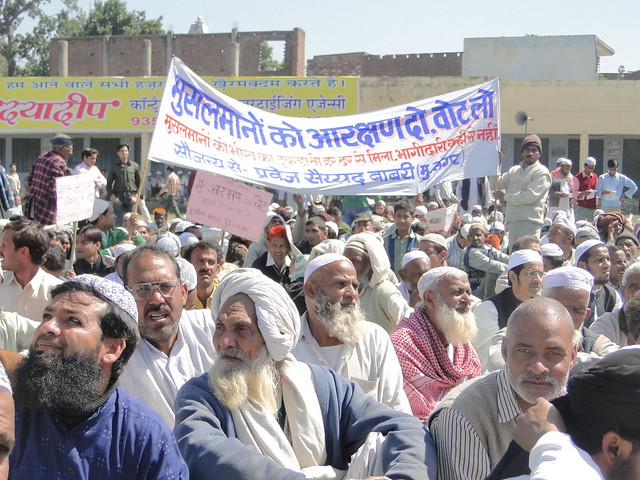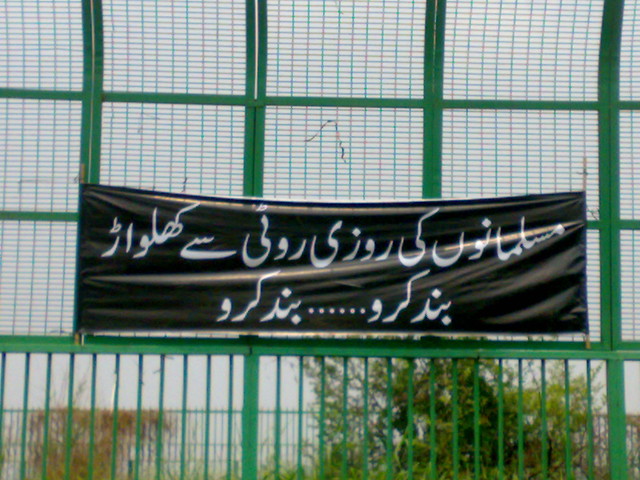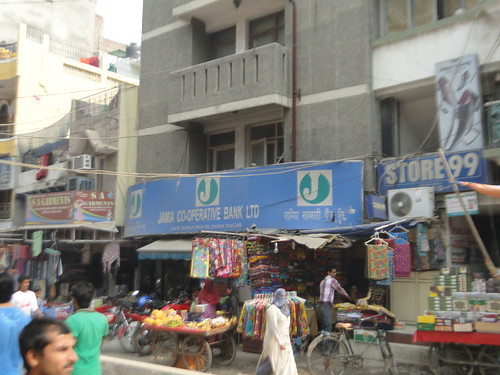By Soroor Ahmed, TwoCircles.net,
Should a community, which has the potential to collect Zakat worth about Rs 50,000 crore annually be equated with Dalits––or be dubbed as inferior to them? Perhaps not. But who would dare to challenge the perception developed ever since the Sachar Committee report was submitted to Prime Minister Manmohan Singh in November 2006.
The figure of Rs 50,000 crore is not the figment of my imagination, but is the outcome of the study done by Mumbai-based Prof Rahmatullah, a noted scholar and Chairman of Jan Sewa. “Ten years back I did a study and the amount was Rs 10,000 crore. By that standard the figure may definitely be Rs 50,000 crore,” he told me recently.

A rally in Muzzafarnagar demanding reservation for Muslims
Prof Imtiaz Ahmed of Jawaharlal Nehru University, New Delhi also did a similar study on the philanthropic aspect of Zakat some years back. Experts somewhat disagree in the exact figure, yet they are of the view that much productive and long-lasting work can be done with the Zakat money.
So by that figure one crore Muslims can be disbursed Rs 50,000 annually from the Zakat amount––it means over Rs 4,000 per month per person, not per family. A person can comfortably live on this much amount even if he or she does no work.
Now come to the Sachar Committee report, which no doubt has its academic significance. But one has reason to question it as it is based on secondary data––such as Census 2001.
Take the example of Census 2011. A senior journalist of Bihar rang me up to inform that nobody turned up at his house to collect data related to 2011 Census. Not only that, he said that many other people in his neighbourhood had a similar complaint. The journalist does not live in any remote village but in the posh locality of Bihar’s capital, Patna, Patliputra Colony. Here prominent bureaucrats, judges and academics of the state live. Needless to say the journalist is not a Muslim. So this is the way our house-hold Census are done and we base our study and consider reports like that of Sachar Committee as Gospel truth.
Yet one cannot reject the Sachar Committee Report out of hand as it has many important things to suggest.
The problem is not with the Sachar Committee report as such, but with the way it is being interpreted and used by Muslim intellectuals, politicians and community leaders. Some of them honestly believe that the report is the most authentic documents and would not at all raise any question––even if there are several––others would just try to use to climb up their political as well as academic ladders.
They would not take into account the fact that in the process, consciously and unconsciously, they are tarnishing the image of the community and instilling hopelessness and despondency among its youth.
The irony is that those, who spoke and wrote on the topic after the Sachar Committee report saw the light of the day, have made no first hand study of Dalits.
No doubt, Muslims do lag behind the Hindus in the field of education and wealth; still they are ahead in several other indicators. For example, an average Muslim live a year longer than an average Hindu, the child mortality rate and infant mortality rate of Muslims are much better than Hindus in general (not just Dalits). The maternal mortality rate of Muslim women is less than Hindus notwithstanding the fact that they give more birth than Hindu women. These are some of the figures of health notwithstanding the fact that their villages and localities have much poorer health infrastructure and poor Muslims face much hardship.

No doubt the government should be blamed for, deliberately or not so deliberately, neglecting the Muslims. This is a fact Muslims know, but the government is not going to listen. So why not the community initiate its own concrete development programme.
How long will the likes of Abusaleh Sharif go on attending the seminar and keep stating the same platitude. Now that he is the Executive Director of the US-India Policy Institute and spends most of the time in Washington DC, he had to return to India repeatedly to keep Muslims reminding that the community is either worse than Dalits, or is slightly better than them.
The need of the hour is to pay less heed to such discussions. As one needs to look like beggar to beg––even if one is not so––some of our community leaders go overboard in sketching the negative picture of the community. They have, in a way, institutionalized beggary. Whether the number of Muslim youths, who have cracked medical, engineering, management, civil services, etc in the last five years have increased or not, needs an objective study. But what is happening is that thousands of boys and girls, even of relatively better off families, are seen wasting their time in getting central government scholarship as per the recommendation of the Sachar Committee report. They buy mobile phones, cricket kit, jeans etc with that amount. Those who really deserve it hardly gets the scholarship.
What now needs to be told loud and clear is that Muslims are not Dalits, nor should there be any comparison with them because of obvious socio-religious reasons.
Take the case of Delhi alone. Right from Julaina to Kalindi Kunj––not to mention of Nizamuddin or Jama Masjid area––lakhs of Muslims of all class live. Thousands of them are millionaire. Offices of all the premier Muslim organizations are situated in these localities. The Zakat collected from Muslims of this pocket of New Delhi is enough to feed and educate the entire needy and deserving Muslims of Delhi.
But the problem, according to Dr Rahmatullah and other scholars, is that these amounts are used in solving the short term problems of the Muslims and the community leaders have hardly initiated any long term programme to improve the lot.
Muslims may not be getting jobs in India easily. Their youth may face some discrimination. But the need of the hour is to tell them that discrimination is a global phenomenon. You will have to excel rather than keep parroting that we are worse than Dalits.

Who can deny that so far remittance is concerned Muslims are better than others. Pay a visit to NRI section of any bank branch and see to it as to how many Muslims and how many Hindus are in the queue. The number of Dalits in them are negligible.
Pay a visit to villages of Siwan in Bihar or Azamgarh in UP: one would find air-conditioners running on generator sets in Muslim houses. I am not talking of Muslims of Hyderabad, Mangalore or Mallapuram.
True some Muslim remittance earners are paying attention to education, yet the fact is that many others sent their sons to Gulf countries just after doing Plus-II or getting a diploma degree to earn fast bucks. They have hardly any plan to go for higher education or appear in high-profile competitions.
It is not just a coincidence that Amir Subhani, presently the home secretary of Bihar, was the IAS topper of 1987. Now the same Muslim concentrated Siwan, the highest remittance earning district of Bihar, struggles to produce any youth who can qualify for the Bihar Public Service Commission.
The sons and daughters of many neo-rich remittance earners either waste their time on Facebook, make boyfriend or girlfriend, or in partying. Of late, many of them have picked up the habit of drinking.
And not to mention of average Muslims marriages. Can any average Dalit match them?

A Poster in Okhla reads in Urdu “Stop playing with means of bread and butter of Muslims.”
The problem is that many of our community leaders have started selling the poverty and backwardness of the Muslims to enter Rajya Sabha or some other good academic position either in India or abroad.
It is true that only two to three per cent Muslims qualify UPSC, IIT, IIM and other such exams, but ironically there are four Muslims in the top 100 richest Indians. This fact surely goes to prove that the community does not make use of its wealth for improving the educational condition as such.
Yes Muslims are making some efforts in the field of education. They have opened a large number of private engineering and some medical colleges, especially in south India. But that has more to do with business and less to do with improving the overall educational status. Can anyone come out with the data showing as to how many such colleges are run by Dalits?
Take the example of construction sector, once again not of Delhi, Hyderabad, Bangalore etc but of Patna, the capital of the relatively backward Bihar. In over three kilometres long stretch between Gandhi Maidan and Sultanganj one can find about 100 apartments with about 2,000 flats. Almost 80 per cent of the owners are Muslims. Even most of the builders belong to the community. In fact there are hardly any Dalit builder in Patna.

True Muslims are backward in several social and economic indicators and the government is not paying attention. But by repeatedly comparing them with Dalits the community leaders are doing great disservice. It is their responsibility to do something more––instill confidence among its next generation and call upon them to look beyond discrimination.
True there are a large number of Muslim artisans and craftsmen, who are facing the brunt of technological changes. Many of them are losing jobs, but this phenomenon is not only confined to Muslims alone. If the demand of tyre and motor mechanic are getting reduced, as now vehicles are coming with tubeless tyres, a large number of youths are becoming car drivers, who are much in demand both here and abroad. Mobile mechanics, computer technicians etc are also attracting the new generation.
Reports like the one presented by Sachar panel does not always tell the entire story. After all there is no denying the fact that the number of Muslims in the 15,000 or so farmers, who commit suicide every year, is negligible.
The need of the hour is to portray the picture of the Muslims as it deserves. There is no need to exaggerate it. One should take into account the fact that the figures of Dalits are sometimes inflated as the government wants to propagate that the heavy amount spent on them are yielding results.
—
Soroor Ahmed is a Patna-based freelance journalist. He writes on political, social, national and international issues.

